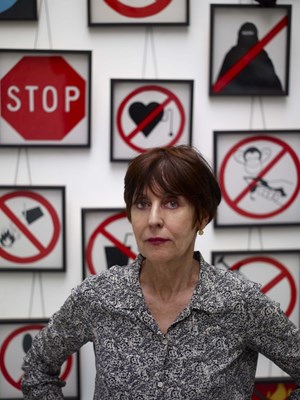
Consider if you will the bolster, a firm tubular pillow used in continental Europe. Right now some 420 of them flood the atrium of the Musée des beaux arts in Calais. They flow from a balcony to the ground floor, where they puddle in a spotlit maze. Amidst this intimate nest, abject puppets sprawl, and play out dark vignettes. But although there is a story here, the narrative is as private as a locked bedroom.
Consider if you will the bolster, a firm tubular pillow used in continental Europe. Right now some 420 of them flood the atrium of the Musée des beaux arts in Calais. They flow from a balcony to the ground floor, where they puddle in a spotlit maze. Amidst this intimate nest, abject puppets sprawl, and play out dark vignettes. But although there is a story here, the narrative is as private as a locked bedroom.
Mistress of this crowded boudoir, Annette Messager, is one of France’s foremost artists and winner of the Golden Lion at Venice in 2005. But she remains hard to pin down. Her public has faced a range of personae, as she has been trickster, peddler, an artist and a collector, a practical maker and a self-proclaimed witch. Her major survey here returns to a cluster of motifs, and the recurrence of puppets, mannequins and fashion appears as fluid as her identity.
The upshot of this self-referencing is that while many of the works here speak to one another, few speak in unambiguous terms with the audience. Puppets appear in three more significant installations: 3 Pantins PQ (2015) where three are pinned aloft with tails of toilet paper; Notre Planète (2014-15), in which they rise and fall on globes made of parachute fabric; and Les Interdictions (2014) where they scale a wall of warning signs. Their struggle is touching, but faceless as they are, they withhold easy readings from the sentient observer.
Not that each work is without intrigue. 3 Pantins PQ reads like a bright, childish crucifixion scene, a bathroom Golgotha. Notre Planète evokes geopolitics and, as has been pointed out, the migrant crisis here in Calais. Les Interdictions, with its rich accumulation of rules and regulations, has a spirit of anarchy. But none of these pieces are didactic. For an artist called Messager, there is very little message. Instead we perhaps have Annette the Trickster, whose works fox viewers and defy paraphrase.

Annette Messager, 3 Pantins PQ
There is little gloss either. These works are not only provisional, they retain a quality that is handmade, even home-made. This is thrown into relief at the Museum of Lace, in which the counterpoint to so many bolsters at the MBA is a forest of lace tools in imitation leather, suspended above the display cases. This is where Messager’s improvisational approach comes up against the well-drilled, mechanised production of a luxury textile.
These menacing black needles, scissors and pins suggest the nearby presence of a predator, perhaps a spider, since the cross-referential imagery spins a web across town. One thinks of the motherly arachnids of French precursor, Louise Bourgeois. But Messager has recast this maligned insect with a bright sidestep and responded to her predecessor with a spider crab, put together out of 13 lacey bras. Lingerie is, of course, every bit as intimate as pillow talk and such found objects will ambush you with a sexual pull.

Annette Messager, 13 soutiens gorge
Lace, too, is a web. The local artist makes this point with a snare-like arrangement of draped tape measures, presented here as a homage to the seamstresses who worked in Calais. Before the turn to digital technology, lacemaking was a dangerous trade causing serious problems to eyesight and hearing. So this elegant sculpture, from another intimate found object, speaks for victims of history, and for workers in sweat shops around the world. Fashion, here, is another web, in which the so called ‘little hands’ of the world are ensnared for life.
If political message this be, it is a highly personal one, a memorial rather than a sermon. Messager grew up in Berck-sur-Mer, 60km from Calais, and addresses the themes which resonate most in this part of the world: the inequities of the garment industry and the crisis nearby at the so-called Jungle. In this respect, she stays true to her formative encounter with art when, as a child, she was taken to see the Burghers of Calais.

Annette Messager, notre planète, 2014-15
Rodin’s monumental outdoor sculpture, which remains in the centre of town, narrates a 14th century event in which six city councillors volunteered for execution to spare the populace. Like the current show, it deals in agony rather than activism. And Messager reports feeling terror before this world famous bronze and a fascination with the outsize key to the city.
It is tempting to say this detail can unlock the rest of her work. But this artist understands the power of meaning held in reserve.
Annette Messager: “Dessus Dessous” can be seen at Musée des beaux-arts and la Cité de la dentelle et de la mode until May 15 2016
Above: Annette Messager portrait Image, 2014, © Marc Domage

ArtDependence Magazine is an international magazine covering all spheres of contemporary art, as well as modern and classical art.
ArtDependence features the latest art news, highlighting interviews with today’s most influential artists, galleries, curators, collectors, fair directors and individuals at the axis of the arts.
The magazine also covers series of articles and reviews on critical art events, new publications and other foremost happenings in the art world.
If you would like to submit events or editorial content to ArtDependence Magazine, please feel free to reach the magazine via the contact page.